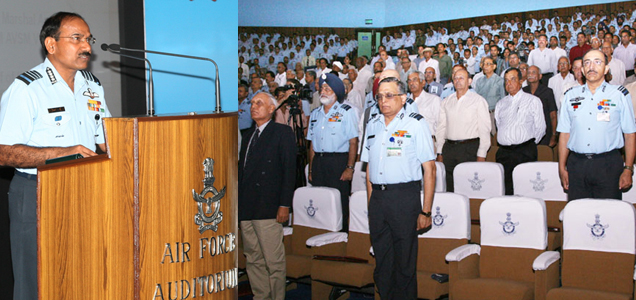 'Lest we Forget'
'Lest we Forget' was the theme that resonated at the AF Auditorium, Subroto Park in New Delhi on 05 Sep 14, where the Indian Air Force (IAF) officials and the veterans of the 1965 India-Pakistan War congregated for a day-long seminar to kick start a series of events spread over a year to commemorate 50 years of the 1965 India- Pakistan war. These events include seminars, homage to martyrs across all IAF Commands and photo exhibitions, to name a few.
Air Chief Marshal Arup Raha, Chief of the Air Staff initially addressed the gathering. In Sep 1965, Pakistan had aunched "Op Grand Slam" aimed to cut off Kashmir from the rest of India. On the very first day, the IAF reacted within 30 minutes of being given the go ahead and engaged the Pakistan Army in a swift and fierce action lasting for 40 minutes in fading light on the evening of 01 Sep 65, in the Chhamb-Jaurian sector.
The IAF destroyed 10 tanks, 02 ack-ack guns and 30-40 vehicles of the Pakistani Army at the cost of four Vampire aircraft. With this unexpected offensive, IAF shattered the dream of Pakistan’s Grand Slam in the late hours of the day, By 4th Sep, the combined Army-Air Force action saw Pakistan lose as many as 22 Patton tanks.
Eminent speakers in the seminar included senior officers from IAF, strategic community and veterans who gallantly fought many of the air battles. They candidly discussed how the IAF overcame many of the limitations in terms of lack of intelligence, radar cover, surface to air missiles, operational training and obsolete A/C etc.
Despite the IAF’s limitations, PAF experienced an attrition rate that was 21% higher than that of the IAF. The story would have been different had the IAF been permitted to retaliate in the Eastern sector, to PAF’s offensive in the West. Contrary to popular perception, the veterans vividly recalled that the IAF contributed 1007 sorties.
The war highlighted the shock effect that an air strike has on the leadership. A single raid on Peshawar forced the residents near the airfield to relocate to safer places further west. Moreover, it was indicative of the reach of the IAF and the fact that no place could be considered safe or a sanctuary from Indian air strikes.
Similarly, a single interdiction mission on the train carrying ammunition for tanks helped in tilting the balance and forcing the Pakistani army leadership to consider accepting ceasefire. All these were indicative of the immense impact that air power could have on the outcome of a war.
Overall, the 1965 War was a turning point in Indian military thinking and preparedness, as it brought out the need for cohesive strategies and procedures in terms of equipment and resources.
The IAF imbibed the lessons learnt from the 1965 war in full earnest, which resulted in telling successes in the 1971 India-Pakistan war and 1999 Kargil conflict.
The procedures for Army-Air Force co-operation were revamped, resulting in considerable reduction in response time to emergent demands of the fighting ground forces. The war highlighted the fact that ultimately, it is the man behind the machine that matters the most, especially under unfavourable conditions.
The fact remains that Indian armed forces faced the challenges and operated in unfavourable conditions and saved the day for the nation. Ultimately, the armed forces prevented the enemy from achieving its goals.
‘Lest We Forget’ is a poignant statement to commemorate the valour and dedication exhibited by the IAF air warriors who made the supreme sacrifice in the line of duty to ensure the safety and independence of the nation and its citizens.
 'Lest we Forget' was the theme that resonated at the AF Auditorium, Subroto Park in New Delhi on 05 Sep 14, where the Indian Air Force (IAF) officials and the veterans of the 1965 India-Pakistan War congregated for a day-long seminar to kick start a series of events spread over a year to commemorate 50 years of the 1965 India- Pakistan war. These events include seminars, homage to martyrs across all IAF Commands and photo exhibitions, to name a few.
'Lest we Forget' was the theme that resonated at the AF Auditorium, Subroto Park in New Delhi on 05 Sep 14, where the Indian Air Force (IAF) officials and the veterans of the 1965 India-Pakistan War congregated for a day-long seminar to kick start a series of events spread over a year to commemorate 50 years of the 1965 India- Pakistan war. These events include seminars, homage to martyrs across all IAF Commands and photo exhibitions, to name a few.